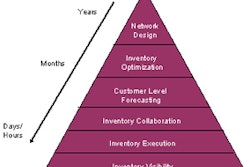
Compiled by Sarah Murray
Green Supply Chains
Are Chemicals Corroding Your Supply Chain?
Mark Wysong, author of The Nontoxic CEO: Protecting Your People, Planet and Profits through Better Chemical Management, notes that American industry spends tens of billions of dollars each year complying with government-mandated environmental health and safety (EHS) regulations. But Wysong believes that procurement organizations typically are ill-equipped to handle the challenges of managing a company's full chemical spend while also helping to ensure EHS compliance.
"It's true that purchasing organizations are set up to deal with supply-side solutions," Wysong says. "But those tend to focus on the largest chemical vendors, volumes and financial impacts. If a large company has 40,000 chemical products enterprise-wide, a supply-side solution would only be set up to look at 10 percent to 20 percent of the largest volume chemicals, say."
Meanwhile, enterprises frequently have many thousands of potentially dangerous and costly smaller chemical volumes and purchases. "We're talking about individual chemical purchases that might average from $100 to $5,000 on an individual transaction and an individual site," Wysong continues. "Those transactions don't tend to be handled through central purchasing. They don't carry enough weight to assign a purchasing manager at headquarters to deal with them."
The Problem with P-cards
Some companies have approached the chemical conundrum by mandating purchases at the local level through a purchasing card. But while these p-card transactions can lower the transaction costs of acquiring the products, they can also contribute to the broader chemical management problem.
"What it actually does is create hundreds and thousands of 'purchasing managers' who may be unknowingly adding to toxicity [and] product redundancy, and who certainly aren't getting enough aggregated volume to get price discounts," Wysong explains. "Central purchasing can't really 'see' what all these thousands of purchasing points are buying. You end up with thousands of products that are intended to do similar functions within a company, but the products are not really that similar."
But the problem is equally great from a spend management standpoint. "We find that 20 percent of the chemical products — which constitutes thousands of products from thousands of vendors — in the aggregate, represent tens of millions and hundreds of millions of dollars for some companies," Wysong says. "Better control can bring literally millions of dollars to the bottom line."
Sourcing/Procurement
Supplier Enablement Seen Still a Top Challenge for Procurement Organizations
Supplier enablement is one of the top three challenges for procurement professionals looking to transform their procurement organizations, gain better visibility into their supplier enablement processes and supplier relationships, and increase spend under management, according to a recent report from technology consultancy Aberdeen Group.
The benchmark report, "Supplier Enablement: Connecting with Suppliers to Build Lasting Relationships," concludes that while enterprises are focused on the financial impact of enabling suppliers and how to increase the volume of automated/electronic transactions, a critical component is the broader utilization of supplier information. Nearly half of the surveyed organizations indicated that their top strategy for supplier enablement is to utilize a supplier information management system.
"Connecting suppliers to an enterprise's supply chain, known as 'enabling,' can help to ensure that companies meet customer demand by procuring categories at the right speed…for the right cost," noted Andrew Bartolini, director of global supply management research at Aberdeen Group. "Best-in-class enterprises demonstrate that supplier enablement can positively impact the business when the right technologies and practices are employed."
Technology
Does IT Matter?
Hackett's research, leaning on benchmarking data from its latest Book of Numbers, finds that world-class IT organizations — those which achieve peak efficiency and effectiveness in Hackett's IT benchmark studies — spend 7 percent more per end-user on IT operations than typical companies. For a typical Fortune 500 company with a world-class IT function, this translates into increased IT spending of $29 million per year relative to their peers.
This investment more than pays for itself by enabling reduced cost and improved performance in finance, procurement, human resources (HR) and other areas of back-office operations. Hackett's research found that world-class Fortune 500 companies run these functions at lower operational costs of $134 million per year ($7.1 million per billion of revenue) compared to typical companies, and process automation and IT enablement play a very significant role in realizing these lower non-IT back-office costs. In addition to this efficiency impact of IT, a direct correlation was found between performance of the IT function and effectiveness in finance, procurement and HR.
Key IT Strategies
Hackett finds that in order to drive the maximum value from IT, leading companies pursue five key strategies:
- Standardize and Consolidate — Leaders streamline and simplify, and to ensure maximum return on investment (ROI) they take the critical step of standardizing master data definitions as they reduce the number of ERP systems and other applications.
- Focus on High Return Opportunities — Leaders take a differentiated approach to IT investment and do careful reward/risk analysis to identify areas that can reap the greatest benefits.
- Don't Indiscriminately Minimize Cost — Rather than focusing on across-the-board cost cutting, these companies take a very different perspective and seek to maximize value at the lowest achievable cost, in part by reallocating spending from technology infrastructure to application management.
- Maximize Value of Information Assets — World-class companies obtain the greatest possible return on their technology investment by maximizing the value of information assets to end-users through data standardization, rich metadata, online information access, analytical capabilities and alignment of the information architecture with business initiatives such as enterprise performance management.
- Outsource Selectively — Leaders outsource carefully, and they use outsourcing as a tool to improve effectiveness rather than efficiency.
Executive Movement
Profile of a Typical CPO
According to the study "Chief Purchasing Officers' Mobility Compensation Benchmarks and Demographics: A Study of Fortune 500 Firms" from CAPS Research, the CPO community is predominately male (87 percent) and the average age is 49 years old. Total annual compensation is $366,000 ($418,000 if female), and the CPO has a staff of 247 associates. The average CPO has been in his or her current position for two or more years and reports to one level below the CEO.
Typical CPOs are responsible for an annual spend of $3.5 billion and have 19 years of purchasing experience. They have been with their current firms for less than six years, are the top purchasing executive for the entire firm and have a B.S. in business and an MBA.
According to the survey, average CPOs attained that post when their predecessors retired or they were the first CPO for the firm. They are not likely to be promoted to a level above CPO before retirement, and they have seen the value (in 2006) of their stock option plans and retirement funds fall since 2001 due to variability in the stock market. Other findings from the study were:
- CPO compensation, adjusted for inflation, has continued to rise over the time period studied.
- There are not discernable patterns of previous experience, education or other variables that were observed to be predictors that an individual would become a CPO for his or her firm, or another firm.
- Titles of CPOs have not homogenized over the time period studied, with a wide variety of titles resulting.
- The study's authors also found that, for a substantial number of CPOs, they were the first to hold the title of CPO in their firm.
There also continues to be a wide variety of factors that make up the goals a CPO must meet to earn their bonus, according to the study. Generally, however, CPOs reported they were satisfied with their compensation packages when compared to their peers in other functions in their firms.



















